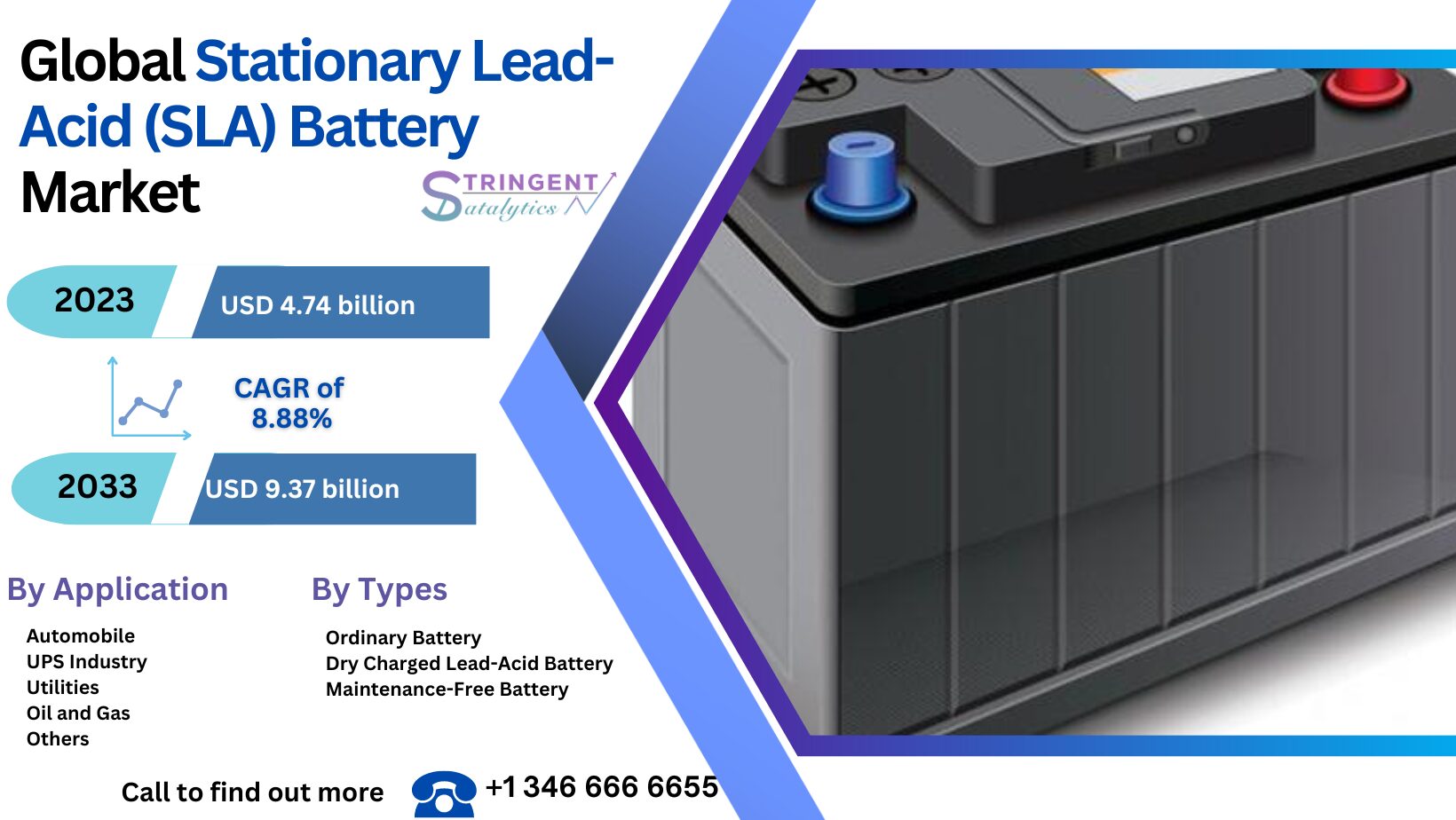The stationary lead-acid (SLA) battery market USD 4.74 billion from 2023 to USD 9.37 billion in 2033. at a CAGR of 8.88% during 2024-2033.
Introduction
The stationary lead-acid (SLA) battery market plays a vital role in providing backup power and energy storage solutions for various industries and applications. This comprehensive overview analyzes key trends, growth opportunities, challenges, end-user demand, and forecasts shaping the SLA battery market landscape.
Overview of Stationary Lead-Acid (SLA) Batteries
Stationary lead-acid batteries are rechargeable energy storage devices commonly used for backup power, uninterruptible power supply (UPS), and energy storage applications. They are characterized by their reliability, low cost, and proven technology, making them a preferred choice for stationary power systems.
Working Principle: Stationary lead-acid batteries operate on the principle of electrochemical reactions between lead plates immersed in an electrolyte solution of sulfuric acid. During discharge, lead plates undergo reversible chemical reactions, converting chemical energy into electrical energy. During charging, the process is reversed, restoring the battery’s energy storage capacity.
Types of SLA Batteries: There are two main types of stationary lead-acid batteries:
- Valve-Regulated Lead-Acid (VRLA) Batteries: These batteries are sealed and maintenance-free, utilizing a recombination process to prevent the escape of gases produced during charging. VRLA batteries include Absorbent Glass Mat (AGM) and Gel batteries.
- Flooded Lead-Acid Batteries: These batteries have open cells filled with electrolyte, requiring periodic maintenance to replenish water loss due to electrolysis. Flooded lead-acid batteries offer high energy density and robust performance but require careful maintenance.
Analysis of Key Trends
1. Growing Demand for Backup Power Solutions: The increasing frequency of power outages due to aging grid infrastructure, extreme weather events, and grid instability is driving the demand for reliable backup power solutions. SLA batteries, with their proven reliability and fast response times, are witnessing growing adoption across various industries and applications.
2. Expansion of Telecommunications Infrastructure: The proliferation of telecommunications networks, including 5G deployment and expansion of broadband services, requires reliable backup power solutions to ensure uninterrupted connectivity. SLA batteries are extensively used in telecom base stations, data centers, and network infrastructure to provide backup power during outages.
3. Rise of Renewable Energy Integration: The integration of renewable energy sources like solar and wind into the power grid is driving the need for energy storage solutions to mitigate intermittency and variability. SLA batteries play a crucial role in storing excess renewable energy for later use, smoothing out fluctuations in power output, and enhancing grid stability.
4. Focus on Energy Storage and Microgrids: The concept of microgrids, decentralized energy systems capable of operating independently or in conjunction with the main grid, is gaining traction. SLA batteries serve as essential components of microgrid systems, providing energy storage and backup power to support critical loads and enhance grid resilience.
5. Advancements in Battery Management Systems (BMS): Technological advancements in battery management systems, including monitoring, control, and diagnostics, are improving the efficiency, reliability, and safety of SLA batteries. Integrated BMS solutions offer real-time monitoring, predictive maintenance, and remote management capabilities, optimizing battery performance and lifespan.
Growth Opportunities
1. Expansion of Data Centers: The exponential growth of data traffic and the increasing demand for cloud computing services are driving the expansion of data center infrastructure worldwide. SLA batteries are essential components of UPS systems in data centers, providing critical backup power to safeguard against data loss and downtime.
2. Electrification of Transportation: The electrification of transportation, including electric vehicles (EVs) and hybrid electric vehicles (HEVs), presents opportunities for SLA battery manufacturers. SLA batteries are used in auxiliary power systems, lighting, and onboard electronics in EVs and HEVs, supporting vehicle functionality and performance.
3. Remote and Off-Grid Applications: Remote and off-grid applications, such as rural electrification, telecommunications, and remote monitoring stations, rely on SLA batteries for reliable power supply. As electrification efforts expand globally, especially in remote and underserved areas, the demand for off-grid power solutions is expected to increase, driving growth in the SLA battery market.
4. Focus on Energy Storage Solutions: The growing emphasis on energy storage solutions to support renewable energy integration, grid stabilization, and peak demand management presents significant opportunities for SLA battery manufacturers. As energy storage projects proliferate, especially in regions with high renewable energy penetration, the demand for SLA batteries as reliable and cost-effective energy storage solutions is expected to surge.
5. Emerging Markets and Applications: Emerging markets, including Asia-Pacific, Latin America, and Africa, present untapped opportunities for SLA battery manufacturers. Rapid urbanization, industrialization, and infrastructure development in these regions are driving the demand for backup power solutions, telecom infrastructure, and off-grid electrification, creating new avenues for market expansion.
Challenges
1. Environmental Concerns: Lead-acid batteries pose environmental challenges due to their lead and sulfuric acid content, which can have adverse effects on human health and the environment if not properly managed. Regulatory compliance, recycling infrastructure, and sustainable battery disposal practices are key challenges facing the SLA battery industry.
2. Competition from Alternative Technologies: The SLA battery market faces competition from alternative energy storage technologies, including lithium-ion batteries, flow batteries, and fuel cells. Advancements in alternative technologies, coupled with declining costs and improving performance, pose a competitive threat to SLA batteries in certain applications and markets.
3. Limited Cycle Life and Energy Density: Compared to alternative battery chemistries like lithium-ion, SLA batteries have limited cycle life and lower energy density, making them less suitable for high-cycle and high-energy applications. Improving the cycle life, energy density, and performance characteristics of SLA batteries remains a challenge for manufacturers.
4. Price Volatility of Raw Materials: The price volatility of lead, a primary raw material used in SLA batteries, can impact manufacturing costs and profit margins. Fluctuations in lead prices, supply chain disruptions, and geopolitical factors pose challenges for battery manufacturers in managing production costs and pricing strategies.
Receive the FREE Sample Report of Stationary Lead-Acid (SLA) Battery Market Research Insights @ https://stringentdatalytics.com/sample-request/stationary-lead-acid-(sla)-battery-market/14324/
Market Segmentations:
Global Stationary Lead-Acid (SLA) Battery Market: By Company
C&D Technologies
East Penn Manufacturing
EnerSys
Exide Technology
GS Yuasa
Global Stationary Lead-Acid (SLA) Battery Market: By Type
Ordinary Battery
Dry Charged Lead-Acid Battery
Maintenance-Free Battery
Global Stationary Lead-Acid (SLA) Battery Market: By Application
Automobile
UPS Industry
Utilities
Oil and Gas
Others
Regional Analysis of Global Stationary Lead-Acid (SLA) Battery Market
All the regional segmentation has been studied based on recent and future trends, and the market is forecasted throughout the prediction period. The countries covered in the regional analysis of the Global Stationary Lead-Acid (SLA) Battery market report are U.S., Canada, and Mexico in North America, Germany, France, U.K., Russia, Italy, Spain, Turkey, Netherlands, Switzerland, Belgium, and Rest of Europe in Europe, Singapore, Malaysia, Australia, Thailand, Indonesia, Philippines, China, Japan, India, South Korea, Rest of Asia-Pacific (APAC) in the Asia-Pacific (APAC), Saudi Arabia, U.A.E, South Africa, Egypt, Israel, Rest of Middle East and Africa (MEA) as a part of Middle East and Africa (MEA), and Argentina, Brazil, and Rest of South America as part of South America.
Click to Purchase Stationary Lead-Acid (SLA) Battery Market Research Report @ https://stringentdatalytics.com/purchase/stationary-lead-acid-(sla)-battery-market/14324/?license=single
Technological Limitations: While SLA batteries offer proven reliability and cost-effectiveness, they have certain technological limitations, including slower charge/discharge rates, lower energy density, and limited scalability. Addressing these limitations through research and development efforts is essential to remain competitive and meet evolving market demands.
End User Demand and Forecasts
1. Telecommunications Industry: The telecommunications industry is a major end user of SLA batteries, driven by the need for reliable backup power solutions to ensure uninterrupted connectivity. As telecom networks continue to expand, especially in emerging markets, the demand for SLA batteries in base stations, data centers, and network infrastructure is expected to grow steadily.
2. Industrial Sector: The industrial sector, including manufacturing facilities, utilities, and critical infrastructure, relies on SLA batteries for backup power, emergency lighting, and process control applications. As industries prioritize resilience and continuity of operations, the demand for SLA batteries as reliable backup power solutions is anticipated to increase.
3. Commercial Buildings: Commercial buildings, including offices, retail centers, and healthcare facilities, utilize SLA batteries in UPS systems to protect sensitive equipment, maintain productivity, and ensure safety during power outages. With the growing importance of business continuity and regulatory compliance, the demand for SLA batteries in commercial buildings is projected to rise.
4. Residential Applications: In residential applications, SLA batteries are used in home UPS systems, solar energy storage solutions, and off-grid power systems. As homeowners seek to reduce energy costs, enhance energy independence, and mitigate the impact of power outages, the demand for SLA batteries for residential applications is expected to increase.
5. Renewable Energy Integration: The integration of renewable energy sources like solar and wind into the power grid requires energy storage solutions to stabilize output and ensure grid reliability. SLA batteries, with their proven reliability and cost-effectiveness, are well-suited for energy storage applications in renewable energy systems, driving demand in this segment.
Forecast: The stationary lead-acid battery market is expected to experience moderate growth in the forecast period, driven by increasing demand for backup power solutions, expansion of telecommunications infrastructure, and the rise of renewable energy integration. However, challenges such as environmental concerns, competition from alternative technologies, and technological limitations may constrain market growth to some extent. Nonetheless, emerging opportunities in data centers, electrification of transportation, remote applications, and energy storage solutions present avenues for market expansion and innovation in the SLA battery industry.
About Stringent Datalytics
Stringent Datalytics offers both custom and syndicated market research reports. Custom market research reports are tailored to a specific client’s needs and requirements. These reports provide unique insights into a particular industry or market segment and can help businesses make informed decisions about their strategies and operations.
Syndicated market research reports, on the other hand, are pre-existing reports that are available for purchase by multiple clients. These reports are often produced on a regular basis, such as annually or quarterly, and cover a broad range of industries and market segments. Syndicated reports provide clients with insights into industry trends, market sizes, and competitive landscapes. By offering both custom and syndicated reports, Stringent Datalytics can provide clients with a range of market research solutions that can be customized to their specific needs.
Reach US
Stringent Datalytics
+1 346 666 6655
Social Channels:




Leave a Reply